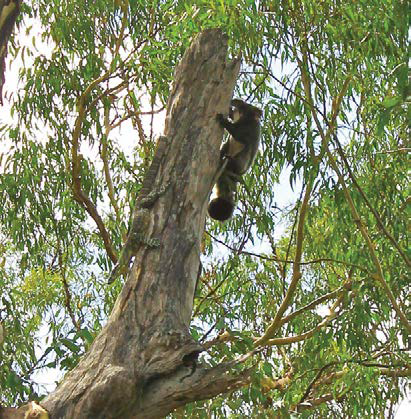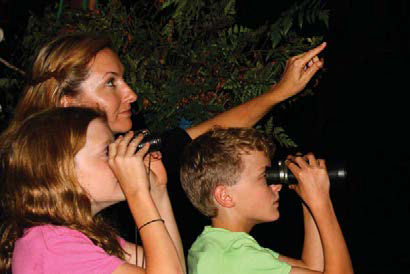The Greater Glider (Petauroides volans) was presumed extinct in the western part of Brisbane, however recent photo evidence indicates something completely different. Land for Wildlife member, Prue Cooper-White, in Upper Brookfield recently reported seeing two pterodactyl-like shapes flying over her house at night. She thought her mind was playing tricks on her because what could be that big?
One morning she heard a strange noise of screeching and screaming coming from a tree less than 10 metres away from the house. The noise was being made by a mammal that looked like a Koala, but was bigger and had a fluffy tail. The penny dropped – it was a Greater Glider! This one was defending its hollow from a Lace Monitor.
Discoveries like this on Land for Wildlife properties are positive indicators that protecting habitat and raising community awareness are valuable ways to retain Brisbane’s unique biodiversity.
 “I was lucky enough to photograph this elusive creature in the daytime while it was defending its nesting hollow against a curious and cheeky Lace Monitor. With ears like a Koala, a small ratty face and a huge bushy tail, it was one of the most interesting looking animals I had ever seen.” Prue Cooper-White.
“I was lucky enough to photograph this elusive creature in the daytime while it was defending its nesting hollow against a curious and cheeky Lace Monitor. With ears like a Koala, a small ratty face and a huge bushy tail, it was one of the most interesting looking animals I had ever seen.” Prue Cooper-White.
After my initial wow factor response to Prue’s spectacular photo of the Greater Glider and Lace Monitor, it got me thinking – was this Lace Monitor drawn to the hollow because of the Greater Glider’s smell, or was it looking for a hollow itself to take a nap? I suppose it may have been doing both of these activities?
This part of Moggill Creek Catchment is in great condition with limited sightings of invasive weeds due to the diligence of dedicated property owners and a high percentage of residents being actively involved in the Land for Wildlife program. However, as with most of South East Queensland (SEQ), this area was selectively logged and there are now limited numbers of large hollow-bearing trees. I am astounded at how many species of animals require numerous hollows for breeding and shelter – over 300 just within the SEQ region. Greater Gliders need 3-18 den sites (hollows) within their home range of about 1.5 hectares.
Greater Gliders are one of six species of gliders found throughout SEQ. The Greater Glider’s diet differs markedly from the other five glider species in that over 95% of its diet consists of eucalypt leaves. The Greater Glider shown in Prue’s photo is in a Spotted Gum (Eucalyptus citriodora subspecies variegata) tree – one of its food sources.
I recently heard a figure that has haunted me ever since. Within every fox, feral cat or wild dog stomach there is an average of 20 native animals. Reducing feral predators on your property can make a real difference and assist with wildlife protection.
 “My family and I have lived here for almost ten years and in that time we have enjoyed exciting encounters with many unusual types of wildlife such as Brush-tailed Phascogales, Satin Bowerbirds, Giant Wood Moths as large as bats and more recently a Greater Glider. For many years we had noticed giant shadows soaring over our rooftop at dusk. We couldn’t work out what we were seeing. Now the mystery is solved!
“My family and I have lived here for almost ten years and in that time we have enjoyed exciting encounters with many unusual types of wildlife such as Brush-tailed Phascogales, Satin Bowerbirds, Giant Wood Moths as large as bats and more recently a Greater Glider. For many years we had noticed giant shadows soaring over our rooftop at dusk. We couldn’t work out what we were seeing. Now the mystery is solved!
Since taking this photograph of a Greater Glider, my children and I have been out every night with our torches and we’ve noticed a pair of Greater Gliders that regularly like to feed in the trees near our house. They stick very close together which surprises me, as Greater Gliders are thought to be solitary animals. It has been rewarding to share my curiosity about nature with my children and to watch their own interest in our natural environment flourish. They are now learning to identify birds just by their calls and are also keen to get further involved in the soft release program for injured wildlife. What a privilege to live so close to nature and to be able to observe it up close. I can’t wait to see what we spot next! ” Prue Cooper-White.
Article by Catherine Madden, Land for Wildlife Officer, Brisbane City Council

Stockland a developer have applied to clear 180 hecs of bush near us in Bellbird park. “ecologists in their report state that the area has potential habitat for greater gliders. What do you reckon? Love to find one before its too late.